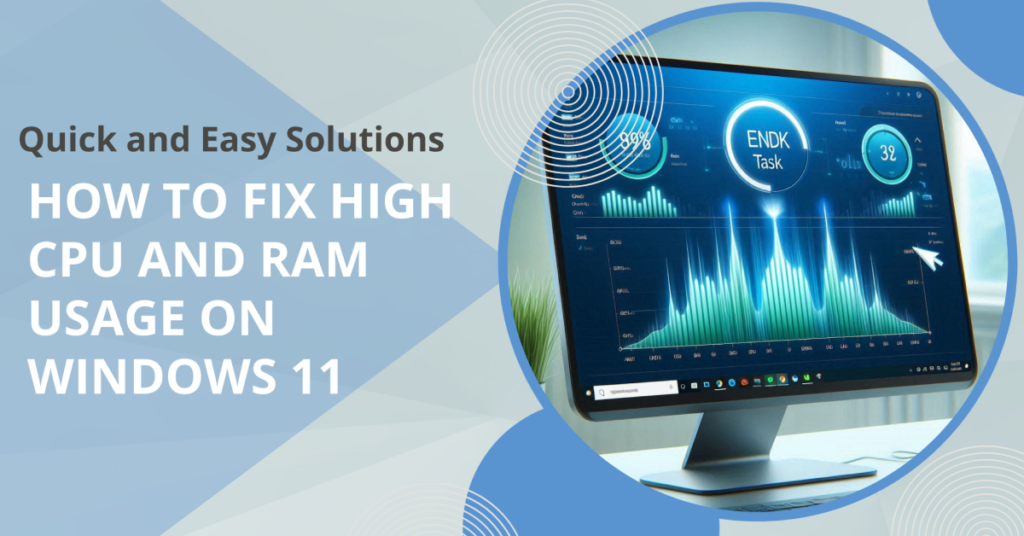If you’re experiencing high CPU and RAM usage on Windows 11 computer, you’re not alone. Many users face this issue, but the good news is that there are several effective ways to fix it. This guide will walk you through the steps to troubleshoot and optimize your system’s performance, specifically for Windows 11. However, most of these steps will work for Windows 10 and other versions as well.
Step 1: Restart Your Computer
Before diving into complex solutions, start by restarting your computer. A simple restart can often resolve high CPU and RAM usage, as it clears temporary files and stops any unnecessary processes.
Step 2: Use Task Manager to Identify Resource-Hogging Apps
Task Manager is a powerful tool that can help you identify which applications are consuming excessive CPU or RAM resources.
- Press the Start menu and type “Task” in the search bar.
- Open Task Manager and navigate to the Processes tab.
- Look for applications using a large amount of CPU or RAM.
- If you find any apps you aren’t actively using, select them and click End Task to stop them from consuming system resources.
Note: You may see system processes like Desktop Window Manager. These are essential for your computer to function properly, so don’t worry if they’re running. Focus on terminating apps that are using too many resources without being necessary. Need Task Manager help? Learn advanced techniques here.
Step 3: Disable Unnecessary Startup Apps
Some apps automatically start when your computer boots up, and they can drain system resources right from the get-go.
- Open Task Manager again, but this time click on the Startup tab.
- Review the list of startup apps and disable the ones you don’t need by right-clicking and selecting Disable.
Be careful when disabling startup apps—some are necessary for updates or other essential functions. Make sure you understand what each app does before turning it off.
Step 4: Optimize Power Settings
Adjusting your power settings can help your computer perform better by prioritizing resources for higher performance.
- Go to Settings > System > Power & Battery.
- Select the High-Performance power plan to ensure your system runs at full capacity.
If you don’t see the High-Performance plan, you can find it by searching for Power Plan in the Control Panel. For Gamers: Try Windows 11 Pro for better resource allocation.
Step 5: Scan for Malware
Malware and viruses can negatively impact your computer’s performance. Run a quick malware scan to ensure your system is free of any malicious software.
- Press Windows Key + S and search for Windows Security.
- Open Windows Security and go to Virus & Threat Protection.
- Click Quick Scan (Microsoft Defender) to check for any threats.
If malware is found, follow the instructions to remove it and improve your system’s performance.
Step 6: Check for Windows Updates
Keeping your system up to date ensures that you have the latest performance improvements and security patches.
- Open Settings and go to Update & Security.
- Check for any Windows Updates and install them if available.
Step 7: Reset Your PC (Last Resort)
If none of the above steps improve performance and your computer is still running slower than expected, consider resetting your PC. This will restore your system to its default state, which can help eliminate underlying issues.
To reset your PC, go to Settings > Update & Security > Recovery and select Reset this PC. Use Windows Server Backup for businesses.
Conclusion
These steps should help resolve high CPU and RAM usage on your Windows 11 system. If you have any questions or need assistance with any of the steps, feel free to leave a comment below, and we’ll get back to you as soon as we can.
For those interested in purchasing genuine Microsoft software at unbeatable prices, check out Indigo Software for great deals on Windows 10, Windows 11, Office, and more. Links are in the description!
By following these tips, you can optimize your computer’s performance and get back to a smooth and efficient user experience.
Video Guide
FAQ,s
Why is “System” using high CPU?
Usually a driver issue. Update drivers via Device Manager.
How much RAM is normal for Windows 11?
4GB+ for basic use. Upgrade to 16GB for gaming.
Can I downgrade to Windows 10?
Yes, but Windows 11 Pro offers better optimization.

